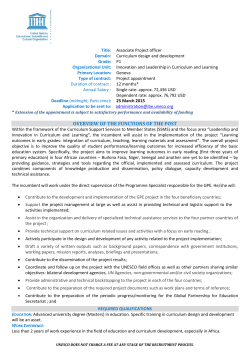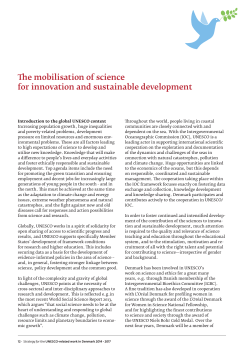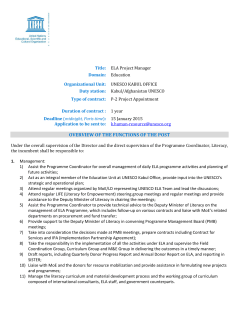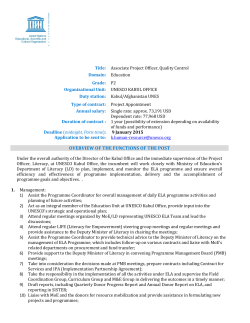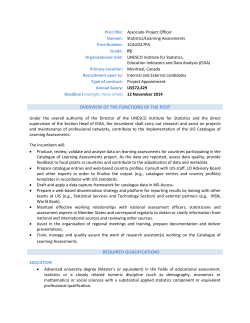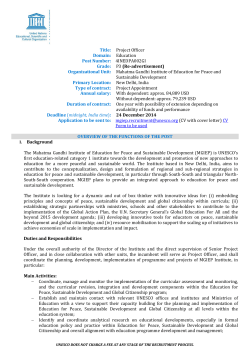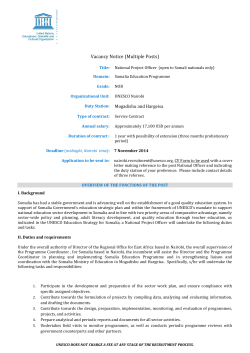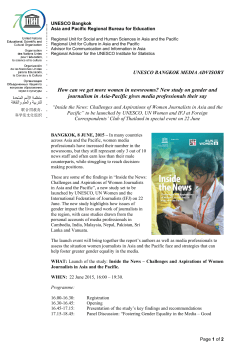
International Arts Education Week info pack
UNESCO International Arts Education Week 25–31 May 2015 Theme: Arts Education for Sustainable Development 2015 International Arts Education Week message by William Barton https://drive.google.com/file/d/0B-ifTSuQRnLLS0dWeGNhdFptbGM/view?usp=sharing Page 1 of 23 Contents Page 1. Introduction: History of International Arts Education Week 2. A brief introduction to the World Alliance for Arts Education 3. UNESCO’s aims for Arts Education 4. Advocacy websites 5. Mediums to utilize 6. What could you do? 7. Advocating: Where and to whom 8. Who can help and how do I approach them? 9. Appendix 1. Example: Short advocacy statement 3. Example: Letter to school board 2. 4. Example: Letter to request appointment 2014 International Arts Education Week message by Sir Ken Robinson 10. References Not e: UNESCO and the World Alliance for Arts Education (WAAE) are supporters of the International Arts Education week (IAEW). However, the specific activities and promotions undertaken and/or suggested in this material are not WAAE or UNESCO activities or events. Page 2 of 23 1. Introduction On 23 May 2012 Irina Bokova, Director General, United Nations Education, Science and Culture Organisation (UNESCO), launched the inaugural International Arts Education Week (IAEW) at UNESCO Headquarters, Paris. Attended by leading international arts education scholars and practitioners, this high profile celebration was a recent international arts education advocacy event that drew attention to the role arts education plays in a global agenda of peace and cultural understanding (see UNESCO charter). The International Arts Education Week was unanimously endorsed by UNESCO’s 182 member states at its November 2011 General Conference (Item 5.13, recalling 35 C/ Resolution 40: On the promotion of arts education). Along with International Arts Education Week the UNESCO General Council also unanimously endorsed the arts education policy document, The Seoul Agenda: Goals for the Development of Arts Education that was developed after the 2nd UNESCO World Conference on Arts Education, Seoul, Korea in May 2010. The World Alliance for Arts Education (WAAE) proudly supports International Arts Education Week and is working with key agencies such as UNESCO, the Korean Arts Cultures Education Services (KACES) and International Network for Research in Arts Education (INRAE) in advocating for International Arts Education Week. We are collectively working to draw attention to the multiple roles education in the arts play in the global agenda of peace and cultural understanding. In 2014 we advocated for Arts for Peace. Please see Appendix Four: Message from Sir Ken Robinson. In 2015 our theme is aimed at education for sustainable development, inclusive of peace. This theme follows on from the WAAE Global Conference, Griffith University, Brisbane, Australia, 26-28 November, 2014 and the UNESCO World Conference on Education for Sustainable Development, Nagoya, Japan, 10-12 November, 2014. This information kit aims to help you advocate for arts education and in particular to help you to connect with sustainable development initiatives and celebrate your activity during International Arts Education week. Page 3 of 23 2. A brief Insight into the World Alliance for Arts Education On 6–9 March 2006, the first UNESCO World Conference on Arts Education brought 1,200 arts education scholars, teachers, community artists, arts education organisations and government ministers together in Lisbon, Portugal. Beyond the presentations and international celebration of arts education, the UNESCO Road Map for Arts Education was announced. Potentially more important was the announcement of the formation of the World Alliance for Arts Education (WAAE). Prior to the World conference, Doug Broughton, President, International Society for Education through Art (InSEA), Dan Baron Cohen, President, International Association for Drama/Theatre Education (IDEA) and Gary McPherson, President, International Society for Music Education (ISME) met during the 2006 InSEA World Congress, Viseu, Portugal. On 4 March 2006, these presidents agreed to form an informal alliance – the WAAE, and in so doing they drafted a declaration. Excerpts are noted below: We have united to define an integrated strategy that responds to a critical moment in human history: social fragmentation, a dominant global culture of competition, endemic urban and ecological violence, and the marginalization of key educational and cultural languages of transformation. We believe that today’s knowledge-based, post-industrial societies require citizens with confident flexible intelligences, creative verbal and non-verbal communication skills, abilities to think critically and imaginatively, intercultural understandings and an empathetic commitment to cultural diversity. For more than half a century, our associations have contributed significantly to the development of curricula and teaching approaches. We are now ready to respond pro-actively to the diverse social and cultural needs of our world…to collaborate with all governments, networks, institutions, communities and individuals who share our vision. One of the initial motivations for forming the WAAE was to collectively critique UNESCO regarding its lack of consultation with grass roots arts educators in the writing of the UNESCO Road Map. Indeed, the WAAE hosted a one-day forum titled ‘Policy to Praxis’ immediately after the UNESCO world conference, where an agenda was established for activating arts educators globally. In 2007, IDEA and the government of Hong Kong co-hosted the WAAE’s first World Creativity Summit which assembled innovators from education, arts, science, policy-making, trade, industry and journalism to discuss strategies and form partnerships to advocate for creative pedagogies in the 21st century. In 2008, InSEA and the Government of Taiwan co-hosted the second phase of this World Creativity Summit. The World Dance Alliance (WDA) joined the WAAE in 2008. WAAE has hosted several World Arts Education conferences and events. Please see the detailed history and upcoming events. Page 4 of 23 3. UNESCO’S aims for Arts Education UNESCO’s aims for arts education are by and large contained within two documents, the Road Map for Arts Education and the Seoul Agenda. These policies open the door for member countries to act upon UNESCO’s global call to arts education. The challenge now is for individual countries to enact this vision and make the next move to implement arts education in a coherent long-term manner. O’Farrell’s (2010) report on UNESCO’s Second World Conference on Arts Education, cited Guingane’s keynote address: Arts education is a means to develop one’s sensibility, emotional intelligence, perception about others, capacity for comparative analysis and understanding toward diversity... arts education has the potential to counter the negative impact of globalisation, with its cultural homogenization, by nurturing creative individuals with their own sense of identity (p.4). The 2nd UNESCO World Conference for Arts Education in 2010 culminated in the development of the Seoul Agenda, which articulated goals for the development of arts education: GOAL 1: To ensure that arts education is accessible as a fundamental and sustainable component of a high quality renewal of education. GOAL 2: To assure that arts education activities and programmes are of a high quality in conception and delivery. GOAL 3: To apply arts education principles and practices to contribute to resolving the social and cultural challenges facing today’s world (p.3-10). In order to benefit all learners, the Seoul Agenda (2010) called upon: UNESCO Member States, civil society, professional organisations and communities to recognise its governing goals, to employ the proposed strategies, and to implement the action items in a concerted effort to realise the full potential of high quality arts education (p.2). Page 5 of 23 The arts make vivid the fact that neither words in their literal form nor number exhaust what we can know. The limits of our language do not define the limits of our cognition. (Elliot Eisner, 2002) Page 6 of 23 4. Sustainable development Sustainable development is defined as development that meets the needs of the present, without compromising the ability of future generations to meet their own needs. (World Commission on Environment and Development, 1987) It is recognised that sustainable development requires balanced progress in four interdependent dimensions (Hawkes, 2001): Social Economic Environmental Cultural Education for Sustainable Development websites include: www.sustainability.edu.au UNESCO’s Teaching and Learning for a Sustainable Future The Australian Research Institute for Environment and Sustainability Australian Sustainable Schools Initiative Enviroschools NZ Education for Sustainable Development Sustainable Development http://www.unesco.org/new/en/unesco-world-conference-on-esd-2014/ https://www.worldwewant2015.org/ www.esd.leeds.ac.uk http://www.gdrc.org/sustdev/un-desd/intro_un-desd.html Learning for a Sustainable Future Second Nature Sustainability Education Green Teacher Global Learning, Inc. The Sustainability Education Center World Resources Institute (WRI) Education Center http://unu.edu/events/archive/conference/higher-education-for-sustainabledevelopment-beyond-2014.html http://www.swedesd.se http://www.iau-hesd.net Page 7 of 23 http://www.unyouth.org.nz/ Auckland War Memorial Museum - http://www.aucklandmuseum.com/ ASB Polyfest - http://www.asbpolyfest.com/ Creative NZ: Arts Council of NZ- http://www.creativenz.govt.nz/ Te Puni Kokiri (Ministry of Maori Development) - http://www.tpk.govt.nz/en/ NZ Ministry of Research, Science and Technology http://www.msi.govt.nz/update-me/archive/msi-archive/msi-annual-report2010-2011-archived/part-two-section-one/morst-performance-measures/ NZ Ministry of Economic Development http://www.business.govt.nz/companies NZ Department of Conservation - http://www.doc.govt.nz/ NZ Department of Internal Affairs - http://www.dia.govt.nz/ NZ Ministry of Environment - http://www.mfe.govt.nz/ NZ Ministry of Education - http://www.minedu.govt.nz/ NZ Ministry of Pacific Island Affairs (MPIA) - http://www.mpia.govt.nz/ NZ Ministry of Foreign Affairs and Trade (MFAT) - http://www.mfat.govt.nz/ UNESCO Small Island Developing States Programme (SIDS) http://whc.unesco.org/en/sids/ Indigeneity in the Contemporary World: Performance, Politics and Belonging http://www.indigeneity.net/ Western Australia: Aboriginal Art Centre Hub - http://www.aachwa.com.au/ WorldCat Identities: UNESCO-UNEP International Environmental Education Programme - http://www.worldcat.org/identities/lccn-n88669199/ UNEP (United Nations Environment Programme) http://www.unep.org/training/ Eco-Schools - http://www.eco-schools.org/ Education First: The World Leader in International Education http://www.ef.co.nz/ United Nations Alliance of Civilisations (UNAOC) http://www.unaocefsummerschool.org/about-us/ Stanford: FSI ~ Institute for International Studies - http://spice.fsi.stanford.edu/ Council on International Educational Exchange - http://www.ciee.org/who/ Page 8 of 23 The BANFF Centre (Indigenous Leadership and Management) http://www.banffcentre.ca/indigenous-leadership/ Indigenous Dance Residency http://www.banffcentre.ca/programs/program.aspx?id=1564 Visual Arts Indigenous Administration and Practice Research http://www.banffcentre.ca/programs/program.aspx?id=1590 Korea Arts and Culture Education Services http://eng.arte.or.kr/index.do UNESCO World Heritage Site - http://whc.unesco.org/en/list/ IOSD: International Organisation of Sustainable Development http://www.iosd.org/ List of Organisations working for Sustainability http://www.gdrc.org/sustdev/a-organizations.html UK Arts Council: Environmental Sustainability http://www.artscouncil.org.uk/what-we-do/our-priorities-201115/environmental-sustainability/ Page 9 of 23 Advocacy websites for Arts Education Helpful readings and sites Below are arts advocacy sites that provide useful ideas and information to make your advocacy more successful. There are many excellent articles available at these and many other sites. Create Tubbles International Society for Education Through Art (InSEA) President’s Committee on the Arts and the Humanities: Reinvesting in Arts Education InSEA advocacy blog Harvard University: Report of the Task Force on the Arts The Wallace Foundation: The Qualities of Quality – understanding arts education Richard Gill: The value of music education Ken Robinson: How schools kill creativity Page 10 of 23 5. Media to utilize include: • • • • • Websites: profiling on websites, blogs, YouTube Physical presentations: performances, talks, workshops, exhibitions Print media: newspapers, posters, Social media: Facebook, Twitter, Google +, Instagram TV and radio: images, stories. 6. What could you do? In your school/ university / organization/ community Use your arts discipline to advocate for the value and relevance of the arts for all children and adults. Page 11 of 23 The following lists may prompt simple and effective action that utilizes your own practices: Presenting (invite news media to all events) • • • • • • • • • • • • • • Formal concert (in a hall or performance space). Informal performance – travelling around the school or university or street. E.g. one or more person presents the spoken word, dance, music or a visual art work and walks to a new location where another group is waiting to present their work. This continues around the school until everyone has finished and a good distance has been covered. Flash mob performance – can be singing, dancing, music or performance art from visual artists. In school or community places such as train stations, shopping precincts, airports. Studio performance where you invite the school/ university/ wider community into your studio to view your work in progress. Write a short play that highlights the importance of the arts and have students perform this. Have all arts works together in a performance to be presented at an assembly, e.g. dance, music and drama respond to one or several moving or still visual art works. Media students provide background images with clear messages about the value of the arts. Local talent competitions, e.g. X Factor, So you think you can dance? Shakespeare shorts: 5 – 10 minute monologues. Variety concerts/ parades/ festivals/ days/ minutes. A shared concert where there is participation from students from other schools in your area, or in the case of a university, students from other disciplines. Comedy revue or play or musical evening. Make a short video ad and put it on YouTube. Organize a school dance (disco) accompanied by school band and led by student arts committee – for students and/or parents or both. Perform at a retirement village, hospital, refugee center, prison, park, museum etc. Page 12 of 23 Talking (invite news media to all events) • • • • • • • • • Invite students to speak about the importance of the arts in education (with a little guidance from you). Invite guest speakers to give a special arts-focused seminar. Ask organization and institutional leaders to make brief mention of IAEW in memos or announcements. Arts advocacy monologues/speech competitions. A debate (or several) on a topic relating to arts education. Students present seminars about inspiring artists. Contact a local community group such as Rotary, Grey Power, Lions, and Members of Parliament etc. While any group would be fine, if you choose a group whose charter is to help in the community, you may gain support to advocate for more arts education. Organize for radio or television coverage of an event or interview. You could do one or all of the following: 1. Advocate for arts education as a guest speaker. 2. Take a group of students to the meeting and have them perform and/or speak on behalf of the arts. 3. Ask for ideas on how to advocate for the arts through their organization. Exhibiting • • • • Exhibit art work in school/community. Celebrate interdisciplinary arts: Visual art exhibition with accompanying music, dance or drama, e.g. dance students could create continuously changing shapes to complement each art work while drama students recite poetry or text alongside the work. Music students play music to accompany the event. This could be something of greater or lesser sophistication. Create posters on the theme for sustainable development in and through the arts that promotes World Arts Education Week. Put them up around the school and in your community, shopping centre notice boards etc. Go one step further and post your posters on the WAAE Facebook page (World Alliance for Arts Education). Contact local galleries and art dealers and ask that special attention be given to art work by children, teachers or that feature content about teaching and learning, or that focuses on the theme of sustainable development. Page 13 of 23 Workshopping (invite news media to all events) • • • Offer a lunch time, after school or evening workshop in your art form for students, teachers or parents (or all three). Offer a community workshop where participants engage creatively with an art form. Present workshop that focus on how arts can foster sustainable development. Inviting parents/grandparents to special days (invite media to all events) • • • Offer parents/grandparents opportunities to stay with their children all day so that they value the achievements of arts education. Invite grandparents to talk about, demonstrate or show their arts. An Arts Week could encompass a focus on a different art form each day of the week. Page 14 of 23 Writing • • • • • • Write an article. This can be in any form. Ensure you support your article with evidence. This will have more of an impact than an emotional plea. Use the theme of sustainable development and explain the importance of the arts in fostering peace, culture economy. Explain how this works. Provide an anecdote about a student or students whose lives were turned around through their involvement with the arts. Write an academic article for an educational journal: 1. Take up a direct call to arms – advocate for more arts in our schools. 2. Discuss the current government focus and how this impacts on the arts in schools. 3. Re-state the benefits to learning through an arts education. Convey a personal message to administrators, school administrators, news media and members of the public about the importance of arts education and follow it up with a phone call or face-to-face meeting. Write a letter to a member of your local, state and national government and follow it up with a phone call or face-to-face meeting. Page 15 of 23 7. Advocating: where and to whom • Local community newspapers • Daily newspapers with a large circulation • National newspapers • Magazine article • Radio interview, local or national • Television: talkback and current affairs or similar • Facebook, YouTube • Twitter • Emails • Other media outlets • Journal articles • School newsletter article • Local Member of parliament/government • Government Minister for Education • Prime Minister/President • Principals’ conference • Conferences in ‘other’ subject areas • Blogs • The Principal/Administrator of school • Board of Trustees or School Board • Parent groups Page 16 of 23 8. Who can help and how do I approach them? Before you contact anyone or seek help you need: A clear message: What do you want to say? (This message should be short and focused – something you can say to someone as you ride the elevator with them!) Think about your target audience and what matters to them. For example: If your country/state/city/region/community has an arts curriculum/program, what are you advocating for? What do people need to understand about the arts? Communicate what could be done to make change. Research: Does your school or institution have a marketing person/department? If so, take your suggestions to the right person and work through them, providing all the necessary information well in advance of the timeline. Allow for hold-ups along the way. Media outlets have their programs planned well in advance. Through Google searches and/or telephone calls, identify the person you are targeting. Ensure you have their correct details and sufficient background information about them. Decide how you wish to approach the person or organization. If you are wishing to make an appointment, write a letter seeking an appointment which can be emailed or sent via snail mail. Follow through with a phone call after a suitable time has elapsed if you do not hear back. Continue to follow up with confirmation of appointment nearer the time. Collaboration: If there are no marketing people who may help you, meet with other arts teachers/ organizations/ leaders/ artists to seek help and formulate a plan. If you are the only one, then go it alone. Sometimes this can be as effective as working with a group. Page 17 of 23 9. Appendices Appendix 1 • Example of a short advocacy statement. Appendix 2 • Example of a letter to request an appointment. Appendix 3 • Example of a letter to your school board. Appendix 4 • 2014 International Arts Education Week message by Sir Ken Robinson Page 18 of 23 Appendix 1 Example of a short advocacy statement (Can be delivered anywhere, staff meeting, dinner party, assembly, community meeting etc). I support arts education for sustainable development as the theme for International Arts Education Week because I believe that arts education promotes personal and social well-being. Arts education develops students’ selfesteem, social interactions and confidence. According to research (Burnard & White, 2008; Cremin, Burnard & Croft, 2006; Serota, 2012) pupils at schools where the arts are integrated into the curriculum show stronger performance in math, English, critical thinking and verbal skills. It is important that schools foster the growth of intellectual intelligence through the arts, wherein educating the whole person is vital if schools are to foster the growth of well-rounded young people. The arts require an engagement of the intellectual, social and emotional levels of communication. Such an engagement of the body, heart and mind is known to develop confidence, self-esteem and wellbeing and features strongly in the school curriculum documents of many countries. Let us focus on the arts in our school/s so we can work together to build a peaceful, culturally tolerant, economic future through our young people by providing them with an opportunity to grow through the arts. Page 19 of 23 Appendix 2 Example of a letter to request an appointment Name Address including postcode Email address/es Phone numbers Date The Honorable Hekia Parata Minister of Education Parliament Buildings Private Bag 18041 Wellington 6160 New Zealand Dear Minister The UNESCO International Arts Education Week will be 25–31 May 2015. The theme for this year is Arts Education for Sustainable Development. I (We) would like to request a brief meeting with you to share information regarding arts in our schools during this week and the need for a strong focus on our arts curriculum throughout the year. I am (We are) available during the week (insert details) when I (we) would be able to travel to Wellington. I (We) would prefer the morning of (insert) if possible, but (insert other options) would also suit. I (We) look forward to hearing from your office to confirm an appointment. I (We) can be reached at the contact details as above. Thank you for your consideration. Yours sincerely, Name Title Organisation Page 20 of 23 Appendix 3 Example of a letter to your school Board Name Address including postcode Email address/es Phone numbers Date The Board of Trustees (Insert relevant address) Dear Board members The UNESCO International Arts Education Week is being celebrated worldwide from 25–31 May 2015. As part of our contribution to the week I would like to speak briefly (provide a rough time estimate of how long you will speak) to your (insert date) meeting. I wish to not only keep you informed of what is happening in the arts at (insert name of school), but outline the benefits of working in the arts for our students. I look forward to your response. Yours sincerely, Name Title Organisation Page 21 of 23 Appendix 4 World Alliance for Arts Education and UNESCO Inaugural International Arts Education Week: 19-24 May 2014 Arts for Peace People everywhere have dreams of peace. These dreams can face deep challenges. Some of the deepest are to do with our different ways of being. They are cultural. Arts education has unique roles in meeting these challenges. Why is that? As human beings, we are born with immense powers of imagination and creativity. Through the languages we speak, the things we make, and the customs we practice, we generate the many different cultures that humanity inhabits. As a result, we all live in two worlds – the world around us and the world within us. We experience both through the filters of our ideas and the tones of our feelings. Some of these we owe to our own dispositions and some to the cultures that envelop us. What have the arts to do with this? We form our worlds not only in words and numbers but in sounds and movement, in images and designs, in rhythms and harmonies. We may call some of these art but they are all part of a larger impulse to understand ourselves and each other. Effective arts education can help us do both. What has this to do with peace? Peace is a state of safety and well-being. It is living without the fact or fear of oppression. Peace is not a material state but a spiritual one. To promote peace around us, we must find peace within us. Our music and images, our poems and performances are ways of exploring some of our deepest ideas and feelings. Peace does not mean lack of passion for our own ways of being. It means compassion for others. Engaging with the arts of others is the most vibrant way of seeing and feeling the world as they do. It’s been said that there is no path to peace: that peace is the path. And so it is. Congratulations then to everyone involved in International Arts Education Week for taking this path together and for knowing that the first and most important step is to believe in this dream and the power of education and the arts to make it real. Sir Ken Robinson, Los Angeles, May 2014 Page 22 of 23 10. Reference List Burnard, P. & White, J. (2008). Creativity and performativity: Counterpoints in British and Australian Education. British Educational Research Journal, 34(5), 667-682. Cremin, T., Burnard, P. & Craft, A. (2006). Pedagogy and possibility: Thinking in the early years. Thinking Skills and Creativity, 1, 2. Eisner, E. (2002). The arts and the creation of mind. New Haven: Yale University Press. Hawkes, J. (2001). The fourth pillar of sustainability: Culture’s essential role in public planning. Melbourne, VIC: Common Ground. O'Farrell, L. (2010). Final Report Closing Session of the Second World Conference on Arts Education. Paper presented at the The Second World Conference of Arts Education, Seoul. Pittman, P. (2012). Sir Ken Robinson is an Education Reformer. Dumbo Feather, 31(2), 78-93 Serota, N. (2012). Britain’s creative edge is at risk: Arts are vital to the economy. To downgrade their status in schools shows a dangerous lack of imagination. The Guardian. Friday, November 12. UNESCO. (2010). Programme of the Second World Conference on Arts Education. Seoul. World Commission on Environment and Development. (1987). Our Common Future. Oxford, UK: Oxford University Press. Page 23 of 23
© Copyright 2025
